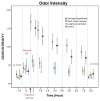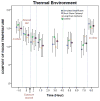Human symptom responses to bioeffluents, short-chain carbonyls/acids, and long-chain carbonyls in a simulated aircraft cabin environment
- PMID: 28440000
- PMCID: PMC5638674
- DOI: 10.1111/ina.12392
Human symptom responses to bioeffluents, short-chain carbonyls/acids, and long-chain carbonyls in a simulated aircraft cabin environment
Abstract
Occupants of aircraft have reported an array of symptoms related to general discomfort and irritation. Volatile organic compounds (VOCs) have been suggested to contribute to the reported symptoms. VOCs are from products used, bioeffluents from people and oxidation reaction products. Thirty-six healthy, young female subjects rated symptoms and environmental quality during an eight-hour exposure to groups of compounds often present in aircraft: (i) long-chain carbonyls, (ii) simulated bioeffluents, and (iii) short-chain carbonyls/organic acids. Statistically more symptoms were identified for the simulated bioeffluents and, to a lesser extent, short-chain carbonyls/organic acids compared to a control condition, although they remained in the acceptable range. There were three temporal patterns in the environmental quality and symptom reports: (i) an adaptive response (immediate increases followed by a decline); (ii) an apparent physiological effect (increases one to three hours into the exposure that remained elevated); and (iii) no statistical differences in reported environmental quality or symptom severity compared to the control air conditions. Typical concentrations found in aircraft can cause transitory symptoms in healthy individuals questioning the adequacy of current standards. Understanding the effects on individuals sensitive to air pollutants and methods to remove the compounds causing the greatest symptom responses are needed.
Keywords: aircraft cabin; bioeffluents; controlled study; symptom reports; volatile organic compounds.
© 2017 John Wiley & Sons A/S. Published by John Wiley & Sons Ltd.
Figures




Comment in
-
Comment on: "Human symptom responses to bioeffluents, short-chain carbonyl/acids and long-chain carbonyls in a simulated aircraft cabin environment" by Weisel et al., Indoor Air (2017).Indoor Air. 2017 Nov;27(6):1224-1225. doi: 10.1111/ina.12398. Indoor Air. 2017. PMID: 29024111 No abstract available.
Similar articles
-
Comment on: "Human symptom responses to bioeffluents, short-chain carbonyl/acids and long-chain carbonyls in a simulated aircraft cabin environment" by Weisel et al., Indoor Air (2017).Indoor Air. 2017 Nov;27(6):1224-1225. doi: 10.1111/ina.12398. Indoor Air. 2017. PMID: 29024111 No abstract available.
-
Influencing factors of carbonyl compounds and other VOCs in commercial airliner cabins: On-board investigation of 56 flights.Indoor Air. 2021 Nov;31(6):2084-2098. doi: 10.1111/ina.12903. Epub 2021 Jul 9. Indoor Air. 2021. PMID: 34240486
-
Passenger evaluation of the optimum balance between fresh air supply and humidity from 7-h exposures in a simulated aircraft cabin.Indoor Air. 2007 Apr;17(2):92-108. doi: 10.1111/j.1600-0668.2006.00458.x. Indoor Air. 2007. PMID: 17391232
-
A critical review of reported air concentrations of organic compounds in aircraft cabins.Indoor Air. 2003 Sep;13(3):292-301. doi: 10.1034/j.1600-0668.2003.00202.x. Indoor Air. 2003. PMID: 12950593 Review.
-
Pollutant exposures and health symptoms in aircrew and office workers: Is there a link?Environ Int. 2016 Feb;87:74-84. doi: 10.1016/j.envint.2015.11.008. Epub 2015 Nov 28. Environ Int. 2016. PMID: 26641522 Review.
Cited by
-
Effects of passive and active leg movements to interrupt sitting in mild hypercapnia on cardiovascular function in healthy adults.J Appl Physiol (1985). 2022 Mar 1;132(3):874-887. doi: 10.1152/japplphysiol.00799.2021. Epub 2022 Feb 17. J Appl Physiol (1985). 2022. PMID: 35175102 Free PMC article.
-
Recent progress on studies of airborne infectious disease transmission, air quality, and thermal comfort in the airliner cabin air environment.Indoor Air. 2022 Apr;32(4):e13032. doi: 10.1111/ina.13032. Indoor Air. 2022. PMID: 35481932 Free PMC article. Review.
-
Impacts of prolonged sitting with mild hypercapnia on vascular and autonomic function in healthy recreationally active adults.Am J Physiol Heart Circ Physiol. 2020 Aug 1;319(2):H468-H480. doi: 10.1152/ajpheart.00354.2020. Epub 2020 Jul 10. Am J Physiol Heart Circ Physiol. 2020. PMID: 32648821 Free PMC article.
References
-
- Chaudhary A, Hellweg S. Including indoor offgassed emissions in the life cycle inventories of wood products. Environmental Science & Technology. 2014;48:14607–14614. - PubMed
-
- NRC. The Airline Cabin Environment: Air Quality and Safety. National Research Council/National Academy Press; Washington, D.C: 1986. - PubMed
-
- NRC. The Airliner Cabin Environment and the Health of Passengers and Crew. National Research Council/National Academies Press; Washington, D.C: 2002. - PubMed
-
- Space D, Johnson R, Rankin W, Nagda N. The Airplane Cabin Environment: Past, Present and Future Research. ASTM International; West Conshohocken, PA: 2000. pp. 189–210. ASTM STP 1393.
MeSH terms
Substances
Grants and funding
LinkOut - more resources
Full Text Sources
Other Literature Sources
Medical

